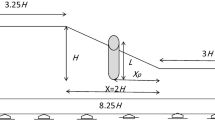Abstract
While the soil nails and the corresponding compound technology are widely used as the support techniques for deep foundation pit and normal slopes, few related engineering cases are found for high loess slopes. By utilizing the finite element software of PLAXIS 8.5, the behavior of a high loess slope reinforced by the combination of soil nails and stabilization piles (hereinafter for CSNSP) is studied in this paper. It can be found that the potential slide surface of the slope moves to deeper locations during the process of the multi-staged excavations. The measure of reducing the weight of the top of the slope is a positive factor to the stability of the loess slope, while the rainfall is a negative factor. The slope can’t be stable if it’s reinforced only by stabilization piles or soil nails during the process of the multi-staged excavations. The soil nail contributes greater to the overall system stability when the excavation depth is relatively shallow, while the stabilization pile takes it over when the excavation depth reaches a large value. Compared to the results from the Sweden circular slip surface, the data derived from the method of phi/c reduction is relatively large when the slope is unreinforced or reinforced only by stabilization pile, and the data turns to be small when the slope is strengthened by soil nails or the combination system of soil nails and stabilization piles.
Similar content being viewed by others
References
Da Costa A, Sagaseta C. Analysis of shallow instabilities in soil slopes reinforced with nailed steel wire meshes. Engineering Geology, 2010, 113(1–4): 53–61
Zhang M, Song E, Chen Z. Ground movement analysis of soil nailing construction by three-dimensional (3-D) finite element modeling (FEM). Computers and Geotechnics, 1999, 25(4): 191–204
Dong C, Zheng Y R, Chen X Y, Tang X S. Research on composite support pattern of soil nails and prestressed anchors in deep foundation pits. Rock and Soil Mechanics, 2009, 30(12): 3793–3796, 3802 (in Chinese)
Feng-bin Z, Lin-chang M, Huan-da G. A case study on behaviors of composite soil nailed wall with bored piles in a deep excavation. Journal of Central South University, 2013, 7(20): 2017–2024
Zheng W, Zhuang X, Cai Y. On the seismic stability analysis of reinforced rock slope and optimization of prestressed cables. Frontiers of Structural and Civil Engineering, 2012, 6(2): 111–120
Rabczuk T, Areias P M A. A new approach for modelling slip lines in geological materials with cohesive models. International Journal for Numerical and Analytical Methods in Geomechanics, 2006, 30(11): 1159–1172
Cai Y, Zhu H, Zhuang X. A continuous/discontinuous deformation analysis (CDDA) method based on deformable blocks for fracture modelling. Frontiers of Structural and Civil Engineering, 2013, 7(4): 369–378
Zhang Y, Chen G, Zheng L, Li Y, Zhuang X. Effects of geometries on three dimensional slope stability. Canadian Geotechnical Journal, 2013, 50(3): 233–249
Zhu H, Zhuang X, Cai Y, Ma G W. High rock slope stability analysis using the enriched meshless Shepard and least squares method. International Journal of Computational Methods, 2011, 8(2): 209–228
Zhao D A, Wang T J, Hui Y P, Chen Z M, Ma Z Q. Summarization on control of subgrade landslide in Baoji-Zhongwei Railway. Chinese Journal of Geotechnical Engineering, 2008, 30(8): 1248–1255 (in Chinese)
Shang H, Ni W.K, Niu F J. Development characteristics and causes of seismic loess landslides in north-west China. Disaster Advances, 2013, (6): 24–38
Wang G X, Xu J L, Liu G D. Landslidology and technique of landslide control. Beijing: China Railway Publishing House, 2004 (in Chinese)
Li J, Tham L G, Junaideen S M, Yue Z Q, Lee C F. Loose fill slope stabilization with soil nails: Full-scale test. Journal of Geotechnical and Geoenvironmental Engineering, 2008, 134(3): 277–288
Liang Y, Xing X L, Li T L, Xu P, Liu S L. Study of the anisotropic permeability and mechanism of Q3 loess. Rock and Soil Mechanics, 2012, 33(5): 1313–1318 (in Chinese)
Otani J, Miyata Y, Mukunoki T. Study of a 15 in vertical soil nailed wall at Capella@Sentosa. In: Proceedings of the 5th International Symposium on Earth Reinforcement (IS Kyushu 07). November, Fukuoka, Japan, 2007
Brinkgreve R B J, Broere W, Waterman D. Plaxis 2D Manual Books, 2006
Author information
Authors and Affiliations
Corresponding author
Rights and permissions
About this article
Cite this article
Wu, Jj., Cheng, Qg., Liang, X. et al. Stability analysis of a high loess slope reinforced by the combination system of soil nails and stabilization piles. Front. Struct. Civ. Eng. 8, 252–259 (2014). https://doi.org/10.1007/s11709-014-0260-z
Received:
Accepted:
Published:
Issue Date:
DOI: https://doi.org/10.1007/s11709-014-0260-z




